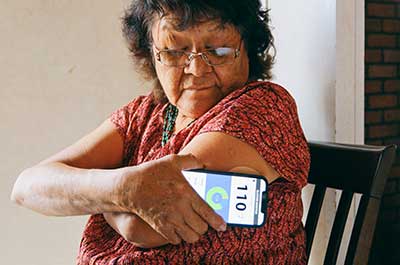When you think about diabetes, you likely think about managing blood sugar, using insulin or maybe losing weight. Your skin is likely not top-of-mind.
But it turns out that people with diabetes have a high risk of developing a variety of skin conditions—some purely cosmetic, others potentially more serious. Sometimes, a skin rash or other issue is the first sign of diabetes.
Why Does Diabetes Affect the Skin?
While it may seem surprising that having diabetes can affect your skin, there’s actually a very strong connection between the two. Your skin is the largest organ in your body. So it stands to reason that a disease that affects any part of your body could also affect your skin.
“Diabetes can lead to poor circulation and that means the skin isn’t getting the blood and oxygen it needs to stay healthy,” says Kathleen Estrada, M.D., an endocrinologist at Henry Ford Health.
The circulation issues common in people with diabetes stem from poor blood sugar control. “Chronically high blood sugar damages the cells that make up blood vessels,” says Dr. Estrada. “And those damaged vessels can no longer transport blood as efficiently.”
Diabetes Skin Changes to Look For
Whether you have diabetes or not, it’s important to be on the lookout for changes to your skin. And if you see anything concerning or out of the ordinary, bring it to your doctor’s attention.
Patches of itchy dry skin, redness, shiny patches or blisters can sometimes occur before you’ve even been diagnosed with diabetes. Making sure your doctor is aware of any new and unexplained rashes is important. The skin condition could be the first sign of high blood sugar.
Skin Conditions Related to Diabetes
People with diabetes are at higher risk for skin conditions related to the disease and those that can affect anyone. Some common skin issues people with diabetes may experience include:
- Acanthosis nigricans: This condition is specific to people with diabetes, especially those who are also overweight. It causes raised brown patches, typically on the neck, groin and armpits.
- Diabetic dermopathy: When blood vessels are damaged from high blood sugar, it can lead to the development of brown, scaly patches on the legs.
- Dry skin: Poor circulation means that skin gets fewer nutrients and less hydration. That can lead to excessively dry skin. It’s often most pronounced on the legs and feet.
- Infections: People with diabetes are at a higher risk for both bacterial and fungal infections. Infection-causing bacteria or fungi are often able to enter the body through cracks in the skin. The lower legs and feet often get so dry that small cracks develop, providing entry for infection.
- Lumps at injection sites: If you inject insulin as part of your diabetes management, it’s important to rotate your injection sites. “Hitting the same spot on the skin repeatedly can lead to irritation, a lump or even infection,” says Dr. Estrada.
How to Prevent Diabetes Skin Conditions

The most important step you can take to keep your skin healthy is to effectively manage diabetes. “Keeping your blood sugar under control helps keep blood vessels healthy, maintains good circulation and reduces the risk of skin-related complications,” says Dr. Estrada.
Good skin care is also essential, especially for people with diabetes. Steps you can take to keep skin hydrated and healthy include:
- Avoid hot showers and baths: Water that’s too hot can zap moisture from your skin. Warm showers are best. If you need to take a bath, keep your soaking time to a minimum. It’s also important for people who have diabetic neuropathy to avoid very hot water. “If you have limited sensation in your feet, you need to make sure the water isn’t so hot it’ll cause burns without you realizing it,” says Dr. Estrada.
- Keep skin clean and dry: When bacteria and moisture build up on the skin, it’s a recipe for infection.
- Moisturize skin daily: Use a thick, emollient cream, especially on very dry skin on the legs and feet.
- Take a close look at your feet: People with diabetes often don’t see—or feel—foot problems until they’ve progressed. Check your feet daily (using a hand mirror if necessary) to look for any cuts, cracks or sores.
“If you notice anything wrong, it’s better to get it addressed sooner rather than later,” says Dr. Estrada. “Left untreated, skin problems in people with diabetes can escalate quickly.”
Reviewed by Dr. Kathleen Estrada, an endocrinologist who sees patients at Henry Ford Medical Center -- Columbus and Henry Ford Medical Center -- New Center One.



